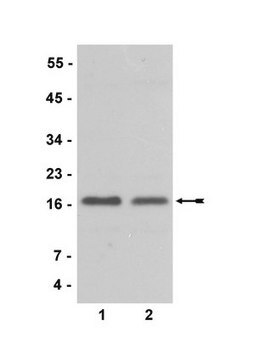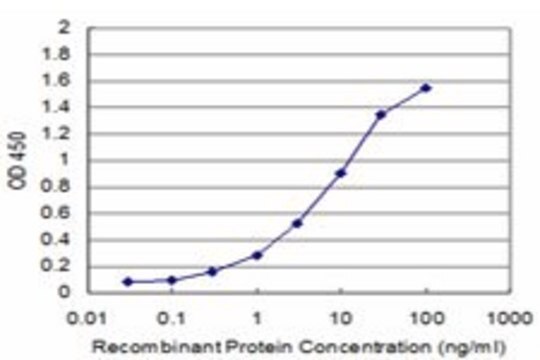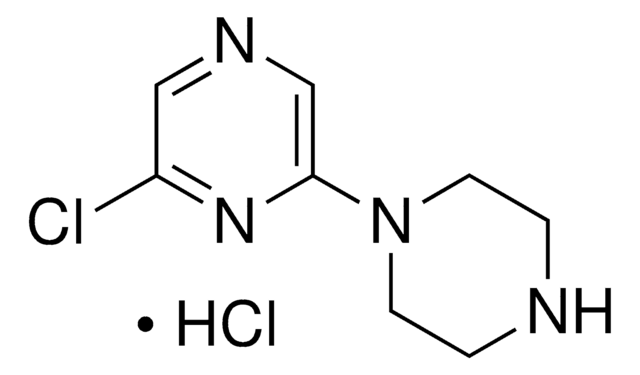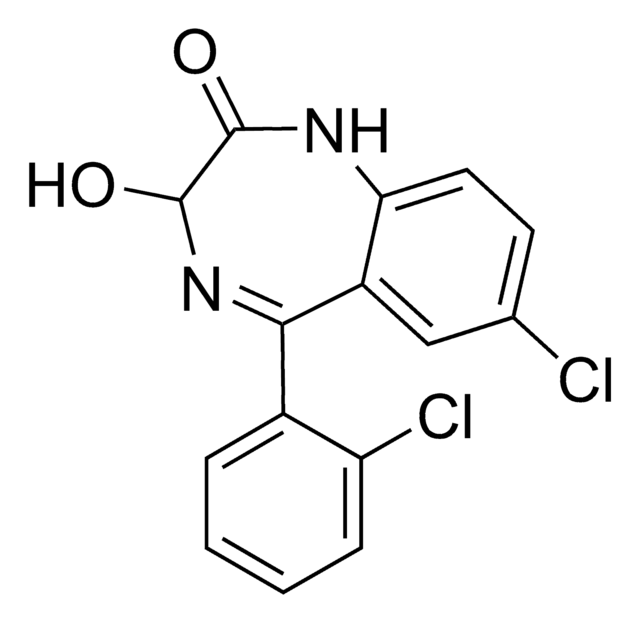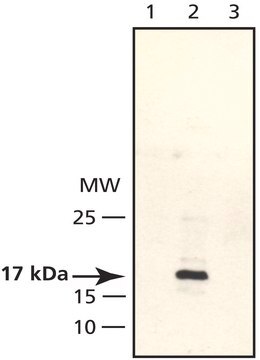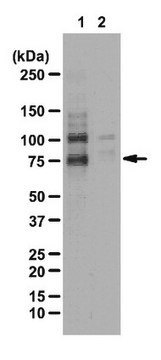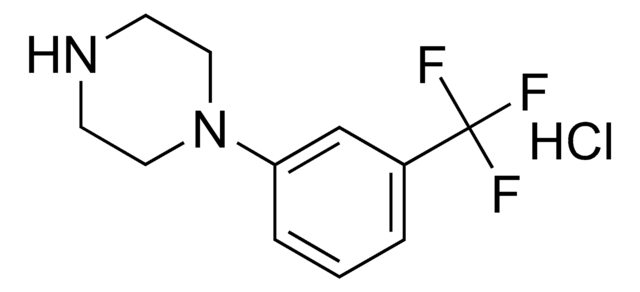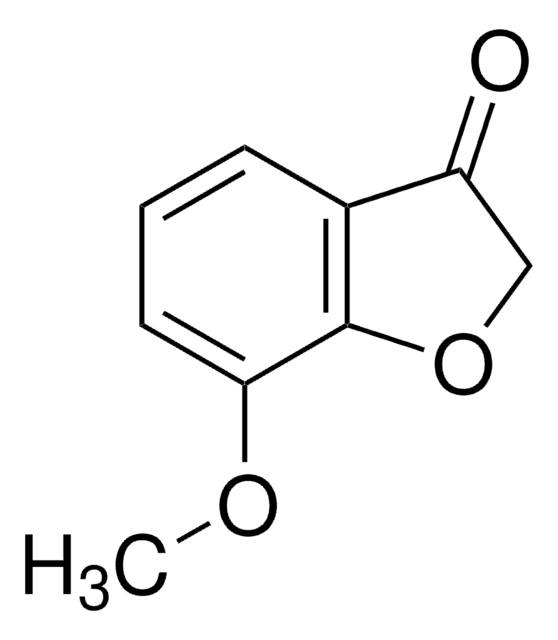04-792
Anti-phospho-CENP-A (Ser7) Antibody, clone NL41, rabbit monoclonal
culture supernatant, clone NL41, Upstate®
Sign Into View Organizational & Contract Pricing
All Photos(3)
About This Item
UNSPSC Code:
12352203
eCl@ss:
32160702
NACRES:
NA.41
Recommended Products
biological source
rabbit
Quality Level
antibody form
culture supernatant
antibody product type
primary antibodies
clone
NL41, monoclonal
species reactivity
human
packaging
antibody small pack of 25 μL
manufacturer/tradename
Upstate®
technique(s)
immunocytochemistry: suitable
multiplexing: suitable
western blot: suitable
isotype
IgG
NCBI accession no.
UniProt accession no.
shipped in
dry ice
target post-translational modification
phosphorylation (pSer7)
Gene Information
human ... CENPA(1058)
Related Categories
General description
CENP-A is a variant version of histone H3 found only at centromeres. It is phosphorylated at serine 7 during mitosis.
Centromere protein A (CENP-A) is a 17 kDa centromere-specific histone variant with 62% amino acids homology to the C-terminal of histone H3. Localized in the centromere, it plays a central role in the centromere-specific chromatin formation. The depletion of histone H3 at the CENP-A binding domain suggests CENP-A to be a possible replacement for histone H3 in the packaging process of α-satellite DNA into primary chromation structure. CENP-A is essential in the formation of specialized nucleosomes at the centromere, implicating CENP-A as a centromere-specific epigenetic marker.
Specificity
CENP-A phosphorylated on serine 7
Others not tested.
Immunogen
peptide containing the sequence RRpSRK in which pS is phospho-serine corresponding to amino acid 7 of human CENP-A (centromere protein A)
Application
Anti-phospho-CENP-A (Ser7) Antibody, clone NL41 is a high quality Rabbit Monoclonal Antibody for the detection of phospho-CENP-A (Ser7) & has been validated in Mplex, WB, ICC.
Research Category
Epigenetics & Nuclear Function
Epigenetics & Nuclear Function
Research Sub Category
Cell Cycle, DNA Replication & Repair
Cell Cycle, DNA Replication & Repair
Quality
routinely evaluated by immunoblot on acid extracted proteins from colcemid-arrested HeLa cells (Catalog #17-306)
Target description
~17kDa
Linkage
Replaces: 05-792
Physical form
Cultured supernantant in 0.05% sodium azide
Storage and Stability
Stable for 1 year at -20°C from date of receipt.
For maximum recovery of product, centrifuge the vial prior to removing the cap. Avoid repeated freeze/thaw cycles, which may damage IgG and affect product performance.
For maximum recovery of product, centrifuge the vial prior to removing the cap. Avoid repeated freeze/thaw cycles, which may damage IgG and affect product performance.
Analysis Note
Control
Acid extracted proteins from colcemid-arrested HeLa cells
Acid extracted proteins from colcemid-arrested HeLa cells
Legal Information
UPSTATE is a registered trademark of Merck KGaA, Darmstadt, Germany
Disclaimer
Unless otherwise stated in our catalog or other company documentation accompanying the product(s), our products are intended for research use only and are not to be used for any other purpose, which includes but is not limited to, unauthorized commercial uses, in vitro diagnostic uses, ex vivo or in vivo therapeutic uses or any type of consumption or application to humans or animals.
Not finding the right product?
Try our Product Selector Tool.
WGK
WGK 1
Certificates of Analysis (COA)
Search for Certificates of Analysis (COA) by entering the products Lot/Batch Number. Lot and Batch Numbers can be found on a product’s label following the words ‘Lot’ or ‘Batch’.
Already Own This Product?
Find documentation for the products that you have recently purchased in the Document Library.
Aisling O'Connor et al.
Biology open, 5(1), 11-19 (2015-12-20)
During mitotic arrest induced by microtubule targeting drugs, the weakening of the spindle assembly checkpoint (SAC) allows cells to progress through the cell cycle without chromosome segregation occurring. PLK1 kinase plays a major role in mitosis and emerging evidence indicates
Grzegorz Dobrynin et al.
Journal of cell science, 124(Pt 9), 1571-1580 (2011-04-14)
During exit from mitosis in Xenopus laevis egg extracts, the AAA+ ATPase Cdc48/p97 (also known as VCP in vertebrates) and its adapter Ufd1-Npl4 remove the kinase Aurora B from chromatin to allow nucleus formation. Here, we show that in HeLa
Anna De Antoni et al.
The Journal of cell biology, 199(2), 269-284 (2012-10-17)
By phosphorylating Thr3 of histone H3, Haspin promotes centromeric recruitment of the chromosome passenger complex (CPC) during mitosis. Aurora B kinase, a CPC subunit, sustains chromosome bi-orientation and the spindle assembly checkpoint (SAC). Here, we characterize the small molecule 5-iodotubercidin
Asha Recino et al.
The Biochemical journal, 430(2), 207-213 (2010-07-16)
RASSF7, a member of the N-terminal Ras association domain family, has increased expression in various cancers and, on the basis of our previous work in Xenopus embryos, may be a regulator of mitosis. In the present study, we address, for
Grégory Eot-Houllier et al.
Nature communications, 9(1), 1888-1888 (2018-05-16)
Sustained spindle tension applied to sister centromeres during mitosis eventually leads to uncoordinated loss of sister chromatid cohesion, a phenomenon known as "cohesion fatigue." We report that Aurora A-dependent phosphorylation of serine 7 of the centromere histone variant CENP-A (p-CENP-AS7)
Our team of scientists has experience in all areas of research including Life Science, Material Science, Chemical Synthesis, Chromatography, Analytical and many others.
Contact Technical Service